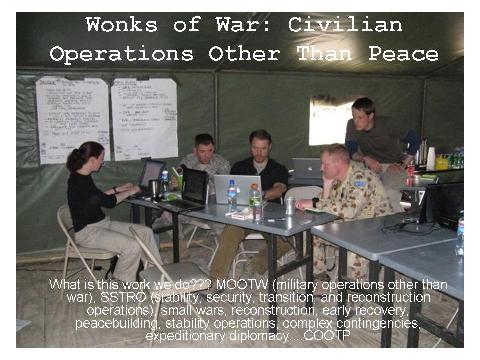McChrystal-izing a Problem: The Militarization of American Statecraft
June 23, 2010
by Gordon Adams
Budget Insight, Stimson Center
General Stanley McChrystal’s candid disrespect for civilian leadership is being treated as an issue of bad judgment and personality. But this episode reveals a much deeper dilemma for American statecraft, one that has long roots but has reached near crisis proportions over the past ten years: the gradual erosion of civilian leadership and the militarization of our foreign and security policy.
Joint Chiefs of Staff Chairman Adm. Mike Mullen warned about this trend in remarks to the Woodrow Wilson School at Princeton University last year, but it has been under way for years. Its manifestations include:
* DOD and the military now define what America’s national security strategy will be. The DOD strategic document – the Quadrennial Defense Review – was for many months the only definitive description of our strategy; the National Security Strategy followed, and is significantly less informative or clear. DOD has for years done our only real national strategy planning, well ahead of any White House guidance.
* DOD and the military have determined that our most important engagement abroad will be to fight terrorist and insurgents, despite the fact that terrorist tactics hardly threaten our existence and, outside of insurgents in Afghanistan (and in decline in Iraq) it is not clear either that there are a lot of insurgencies for us to fight or that other countries will welcome a major US military presence to deal with those that do exist.
* The regional combatant commanders are a more prominent US forward presence in most regions of the world than our ambassadors or regional Assistant Secretaries of State.
* These same regional combatant commanders seek to become the “hub” around which all US government agencies engage the world. Adm. James Stavrides, as COCOM for Latin America described that command as a “velcro cube” to which other civilian agencies could attach. AFRICOM was deliberately created to be such a command, despite the absence of any formal civilian role or authority in the operations of such a command.
* The Commander’s Emergency Response Program (CERP) was designed and implemented as a development assistance program entirely under the authority of the local commanders in Iraq and Afghanistan. In funding, it is as large as thecivilian Millennium Challenge Corporation and nearly as large as USAID’s development assistance (DA) funds. During the Bush administration, DOD sought to make CERP a global development assistance program and an article in the latest Foreign Affairs proposes that the military be given responsibility for all US bilateral development assistance.
* (more…)
Subscribe to:
Post Comments (Atom)

No comments:
Post a Comment